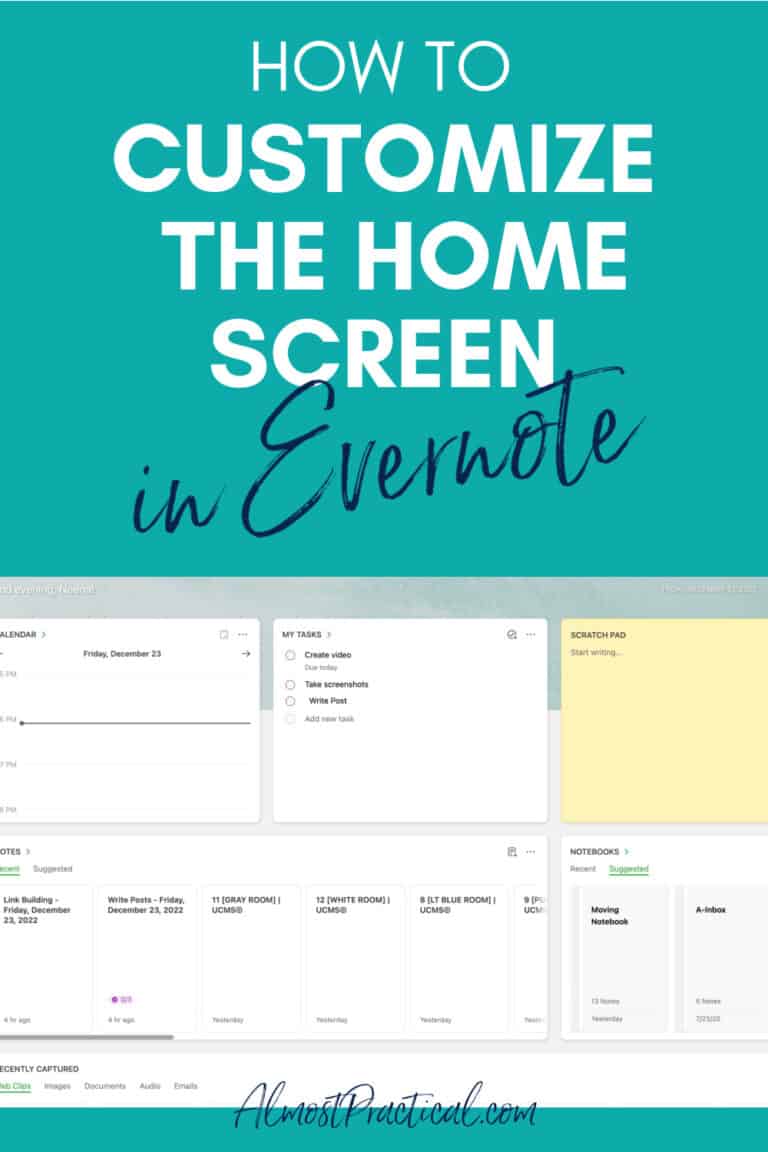Do SMART Goals Really Work?
This post may contain affiliate links which means I make a commission if you shop through my links.
Disclosure Policy
What are SMART goals? Can they help you be more productive or are they a waste of time?
How many times have you set goals for yourself only to have them fizzle out before you even really get started?
It used to happen to me all the time – and truth be told, it still does.
But ever since I started following the SMART framework for goal setting, I have to say that I have been accomplishing more than in the past.
The word SMART in SMART goals is an acronym for the following:
- S – Specific
- M – Measurable
- A – Achievable
- R – Relevant or Realistic
- T – Time Bound

What are SMART Goals?
Basically SMART Goals is a framework that you can use when setting your goals.
This framework makes you narrow the scope of your goal to be achievable and realistic – and it makes you set a deadline so you can measure your progress as you move towards your end result.
Why Are SMART Goals Important?
SMART goals are important because without the right components you might find that you never really accomplish the the things that you set out to do.
Often we have these “pie in the sky” goals that seem great at first – but once we try to get there we realize that they are not really attainable.
Goal setting with the SMART Goal framework helps you to avoid this fiasco and to create goals that stick.
The 5 Components of SMART Goals
Let’s take a closer look at the 5 components of SMART Goals.
S – Specific
The S in SMART Goals stands for Specific.
When setting a goal, you want to make sure that the scope is not too broad.
Your goal cannot be as broad as “I want to lose weight.”
Instead, think of something specific that you can personally do to contribute to the solution:
- Exercise
- Eat healthy foods
- Improve sleep habits
- Eliminate sweets
- Join a support group
- Find an accountability partner
M – Measurable
The M in SMART Goals stands for Measurable.
You should also have a way of measuring your progress towards your goal – otherwise how will you know when you have actually achieved it?
Even if your goal is specific, that is not enough.
You can’t just say – I want to lose weight by exercising and eating healthy.
Rather, you can add many components of measurement into it:
- How much weight do you want to lose?
- How many times per week will you exercise – and for how long?
- What types of healthy food will you eat – how many times per day?
A – Achievable
The A in SMART Goals stands for Achievable.
When creating your goals, you need to have a reasonable expectation of being able to achieve them.
This is how you set yourself up for success.
Your Specific and Measurable goal might be – I want to lose 10 pounds by exercising 3 times per week for 2 hours per session and eating salad daily for lunch and eliminating sweets from my diet.
To make the goal achievable, you need to answer some questions for yourself:
- Do you have access to exercise facilities?
- Does your schedule allow for exercise sessions of 2 hours each?
- Do you like salad?
- Will your sweet tooth complain if you eliminate sweets? Should you allow yourself a “cheat” day for dessert?
R – Relevant or Realistic
The R in SMART Goals stands for Relevant or Realistic.
The thing that you want to accomplish – it should be relevant to where you are in life or work right now.
Losing 10 pounds through diet and exercise is an admirable goal but there are a few things that can get in your way.
- Are the holidays right around the corner? It might be hard to eat healthy at this point in time.
- Do you have a big work deadline coming up where you will have to work overtime? Exercising for 2 hours, 3 times a week may not be possible.
When setting SMART Goals, pay attention to what is going on in your life outside of the goal that you are creating for yourself.
T – Time Bound
The T in SMART Goals stands for Time Bound.
Your goal should not be open ended – you need to give yourself a deadline.
A deadline is a powerful tool to help you track your progress and know when you have met your goal.
If you want to lose 10 pounds – set a time frame by which you want to hit your ideal weight.
If your goal is to lose 10 pounds in 12 weeks – then you can do a weigh in at 6 weeks to see if you are on track.
By tracking your progress, you can adjust your goal or your deadline, if needed.
Why SMART Goals Don’t Work
The SMART Goals framework is an excellent method for goal setting.
But sometimes, it is not enough.
Sometimes you need a little extra something to motivate yourself to cross that finish line.
According to Michael Hyatt, that missing component is excitement.
In Michael Hyatt’s book Your Best Year Ever – he takes the SMART acronym one step further.
His goals acronym is SMARTER – where the “E” stands for excite.
Your goals need to excite you.
The excitement is what gives you the motivation to get them done.
If you stick to the traditional SMART goals template then you will hold yourself back.
Setting achievable goals is setting the bar too low.
This article in Forbes goes as far as to say that people who set SMART goals are less likely to love their job because they are not setting big, audacious, exciting goals and are settling for less.
What is the Difference Between SMART and Stretch Goals?
SMART and Stretch goals are very different types of goals.
According to the Harvard Business Review two characteristics of stretch goals are:
- extreme difficulty and
- extreme novelty.
Extreme difficulty means that these goals are so big that they are seemingly unattainable.
Extreme novelty means that to accomplish these goals you need to reinvent, recreate, reimagine the way things are currently done in order to achieve them.
Stretch goals fall outside of the “achievable” and “relevant/realistic” boundaries of the SMART Goals framework.
But Stretch goals are more likely to excite you than SMART Goals.
So, should you set Stretch goals or SMART Goals?
Personally, I would create a combination of both – because it is important to think big, too.
You can set big Stretch goals and break them down into smaller goals that use the SMART framework.
Here are some examples of people that accomplished more than what they ever thought was possible:
- This couple paid off $10,000 in debt in 10 weeks. I bet that goal didn’t seem very “achievable” at first!
- Arthur Boorman was a disabled veteran who was told that he would never walk unassisted again. He could have set an achievable goal of working within the limits of his disability. Instead he set out to overcome it. He found success through hard work and guidance – and despite his best efforts, the outcome could have been different, but he would not have known if he didn’t try.
SMART Goals Examples
The following 2 scenarios are examples of SMART goals, they are specific, measurable, achievable, relevant, time bound – and they also do excite the person making the goal.
Progress can be monitored on both goals periodically throughout the time frame. This allows the goal setter to make sure their strategy is working and make some tweaks if necessary.
Example 1 – Lose Weight
Finishing off the example from above about losing weight – this would be an example of a SMART goal:
I want to lose 10 pounds over the next 12 weeks by going to the gym 3 times per week for 2 hours per session, eating salads for lunch daily, and eliminating desserts except on Fridays. I am doing this because I want to fit into my absolute favorite pair of jeans by the fall.
Example 2 – Save More Money
I want to increase my savings account by $12000 within 9 months because I want to have a downpayment to buy a house. I will do this by saving 30% of my paycheck, cutting my expenses on x, y, and z, and investing my existing savings in x (stocks, bonds, funds) with an expected x% rate of return.
How to Write Smart Goals
The easiest way to write SMART goals is to write the acronym down on a piece of paper.
Then, write your goal underneath in one sentence.
Read through your goal and check of each letter in SMART that you have included in your goal.
Refine and adjust your sentence until you are certain that you have covered all of the components.
Related Posts
- 10 Organizing Tasks You Need to Squeeze Into Each Day
- How to Get Organized – Focus on 3 Core Areas
- The ONE Thing by Gary Keller and Jay Papasan
No Goal Is Too Small to Be SMART
Most of the articles about SMART Goals relate to the work place.
But you can absolutely use the framework for mundane everyday life.
Perhaps you have a really messy house that you need to clean and organize.
Break that big decluttering goal down into small goals for each room.
Outline what you want the end result to look like, what steps you can realistically take to make it happen, and give yourself a deadline.
Then, make it exciting by rewarding yourself as you work through each goal.
Clean the closet – make room for a new outfit.
Clean the bathroom – make time for a long bath or shower.
Your reward can be whatever makes you excited to get the task done.
Yes, SMART Goals Really Do Work
Goals that are SMART – specific, measurable, achievable, relevant, and time bound – do work.
When you apply this framework to the things that you want to accomplish – whether big or small – you are creating a concrete plan that you will be more likely to follow.








Hi Neena,
It was a beneficial read! I have never really herald about SMART goals. So, it was a completely new thing for me. I am glad that you shared this on your platform, it was a very helpful read, and not only did I learn about it, but I was also able to decide whether or not they will work for me. Thanks a lot for sharing about SMART goals, and also sharing your honest opinion on them. It was a great read for me.
These are great tips, and they can be applied to anything, including home organization. Having a concrete plan and then sticking to the plan will bring results. Good job with this article!